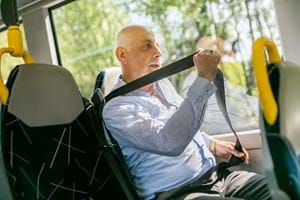Report on seat belt use
There is no doubt that buses are a very safe mode of transport – in fact they are the safest option on our roads. But in the event of an incident, wearing a seat belt could be the difference between life, and in the worst case, death. It is also a legal requirement to use a seat belt in all buses where seat belts are available, and a requirement to provide information about this on signs and in announcements

Only 10 percent of travellers use a seat belt
Unfortunately, seat belt use is far too low, about 10 percent on average, or one in ten travellers. We know that from a survey we carried out in October and November in 2024 of seven regions of Sweden. The survey comprised 1,616 bus journeys and nearly 25,000 travellers.
At the same time, there are significant differences between the regions. One in three travellers use a seat belt in Östergötland, but less than 1 percent in Stockholm. If we do not include the capital, average usage is 18 percent. The report pertains to Sweden, but it is reasonable to assume that it is also relevant to other Nordic countries such as Norway and Finland. Denmark does not have the same legal requirement.
Low level of awareness
While the study did not investigate the reasons for the low use of seat belts, previous studies have identified the following main reasons:
- Many people do not know that using a seat belt is compulsory.
- Buses are considered very safe because of their size.
- Putting a seat belt on feels awkward, especially for short trips.
- Other travellers do not use a seat belt.
Nobina winner of the Golden Belt Initiative
Nobina is already working in various ways to increase belt use and in November 2024, at the largest public transport fair in the Nordic region – Persontrafik – we won both first and second place in the Golden Belt Initiative together with our clients, Sörmlandstrafiken and Värmlandstrafiken.
A top priority going forward
Prizes and distinctions are fun, and show that we are on the right track. But when it comes to getting travellers to wear their seat belts, there is still a long way to go. Based on the results in the report, seat belt use will therefore be a top priority for Nobina going forward. At the same time, this is an issue where the entire industry needs to work together with travellers, clients and authorities to raise awareness and change the culture, so that it becomes as natural to use a seat belt on the bus as in the car.